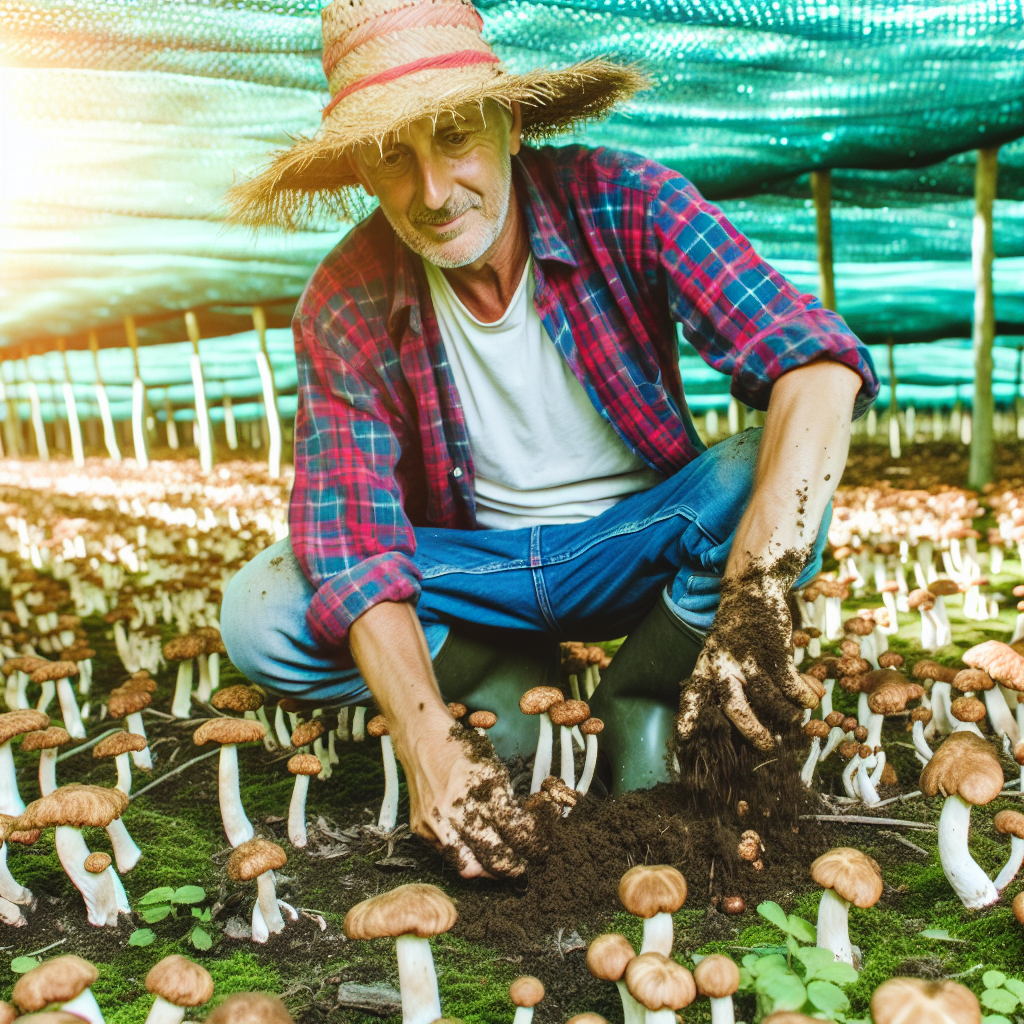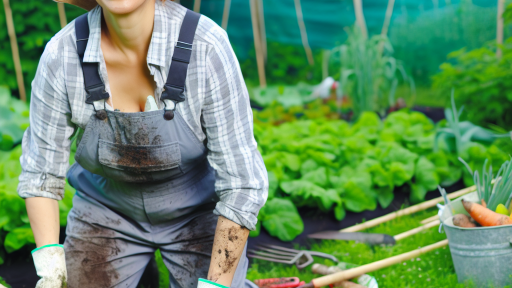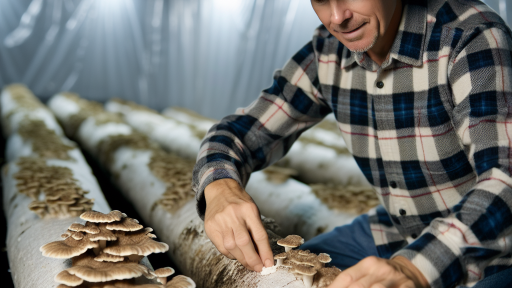Introduction to DIY Mushroom Growing Kits
Understanding the Basics
DIY mushroom growing kits offer an accessible way to cultivate mushrooms.
These kits provide essential tools and materials for successful growth.
They cater to both beginners and experienced small-scale farmers.
Utilizing these kits can enhance the efficiency of mushroom production.
Benefits for Small-Scale Farmers
Small-scale farmers experience numerous advantages from DIY mushroom kits.
Firstly, they promote sustainable farming practices.
Additionally, farmers can diversify their crop offerings with mushrooms.
Growing mushrooms also provides a unique income stream.
Cost-Effectiveness
DIY kits are often more affordable than traditional farming methods.
Farmers save on startup costs associated with larger scale operations.
This cost-effectiveness enables better resource management.
Consequently, it allows farmers to reinvest savings into their business.
Minimal Space Requirements
Mushrooms require less space compared to traditional crops.
Thus, these kits suit small farms with limited land availability.
Farmers can utilize indoor areas or small greenhouses effectively.
Transform Your Agribusiness
Unlock your farm's potential with expert advice tailored to your needs. Get actionable steps that drive real results.
Get StartedThis flexibility aids in maximizing farming potential.
Education and Engagement
These kits provide an opportunity for farmers to learn new skills.
Farmers can experiment with different mushroom varieties.
Engaging in mushroom cultivation promotes community interest.
This engagement can lead to collaboration and knowledge sharing among farmers.
Understanding Mushroom Varieties
Exploring Popular Types
Mushrooms come in various types, each with unique characteristics.
Understanding these varieties helps farmers choose the right one for cultivation.
Common types include shiitake, oyster, and portobello mushrooms.
Each type has specific growth conditions and market demands.
Shiitake mushrooms are prized for their rich flavor and texture.
Oyster mushrooms grow quickly and are versatile in culinary uses.
Portobello mushrooms are popular for their meaty texture and size.
Assessing Your Farm’s Conditions
Evaluating your farm’s environment is crucial for successful mushroom farming.
Consider factors like temperature, humidity, and available space.
Shiitake mushrooms thrive in warm temperatures and moist conditions.
In contrast, oyster mushrooms prefer cooler environments.
Furthermore, assess the type of substrate you will use for growing.
Common substrates include sawdust, straw, and coffee grounds.
Market Demand Considerations
Researching local market demand shapes your mushroom selection.
Shiitake mushrooms often fetch higher market prices due to their popularity.
Oyster mushrooms are frequently sought after for their taste and versatility.
Portobello mushrooms are commonly used in vegetarian dishes and burgers.
Understanding consumer preferences helps guide your choices effectively.
Experimenting with Unique Varieties
Consider trying less common mushroom varieties for niche markets.
Showcase Your Farming Business
Publish your professional farming services profile on our blog for a one-time fee of $200 and reach a dedicated audience of farmers and agribusiness owners.
Publish Your ProfileLion’s mane and maitake mushrooms are gaining popularity for their health benefits.
These unique types can attract new customers looking for specialty products.
Experimenting allows you to diversify your offerings and expand your market reach.
Essential Materials and Tools Needed for DIY Mushroom Kits
Basic Materials
To start, gather high-quality mushroom spores or spawn.
Select a suitable substrate for mushroom growth.
Common options include straw, sawdust, or coffee grounds.
Make sure to also have water for adequate moisture levels.
Container Requirements
Use plastic containers or jars to hold the substrate.
Ensure they have adequate airflow for the mushrooms.
You may need lids or filters to prevent contamination.
Tools for Preparation
Gather essential tools for preparing your mushroom kits.
A knife or scissors will help cut substrates accurately.
Use a mixing bowl to combine moisture and substrate evenly.
Include a measuring cup for precise water measurements.
Cleaning Supplies
Maintain cleanliness to prevent contamination.
Use isopropyl alcohol to sanitize your tools and containers.
Have disposable gloves to ensure a sterile environment.
A clean workspace is crucial for successful mushroom cultivation.
Optional Equipment
Consider using a pressure cooker for sterilizing substrates.
A thermometer can help monitor temperature during incubation.
Humidity monitors assist in creating optimal growing conditions.
Lighting may also enhance mushroom growth, particularly for certain varieties.
Learn More: Climate Control Strategies for Mushroom Cultivation
Step-by-Step Guide to Assembling Your Own Mushroom Growing Kit
Creating your mushroom growing kit is an enjoyable process.
Start by gathering all necessary materials.
You will need a substrate, mushroom spores, and a suitable container.
Gathering Required Materials
The first step involves selecting the right substrate for your mushrooms.
Common substrates include straw, wood chips, or coffee grounds.
Next, purchase mushroom spores from a reputable supplier.
Ensure the spores match your chosen substrate type.
Finally, choose a container to house your growing kit.
A plastic bag or a large glass jar works well for this purpose.
Preparing the Substrate
Begin preparing your substrate by sterilizing it.
Use steam or pressure cooking to eliminate any contaminants.
Allow the substrate to cool before adding the mushroom spores.
This cooling process is crucial for successful germination.
Inoculating the Substrate
Once the substrate has cooled, carefully mix in the mushroom spores.
Ensure you use clean hands or gloves to maintain hygiene.
Distribute the spores evenly throughout the substrate for uniform growth.
After mixing, pack the substrate firmly into your container.
Showcase Your Farming Business
Publish your professional farming services profile on our blog for a one-time fee of $200 and reach a dedicated audience of farmers and agribusiness owners.
Publish Your ProfileCreating the Ideal Growing Conditions
To promote mushroom growth, provide a moist environment.
Spray water periodically to maintain humidity levels.
Cover the container with a ventilation lid or breathable fabric.
This setup encourages airflow while retaining moisture.
Monitoring Growth
Keep an eye on your kit as the mushrooms start to grow.
Look for signs of mycelium, which appear as white threads.
Once fully colonized, the substrate will be ready for fruiting.
Harvesting Your Mushrooms
When mushrooms reach maturity, it’s time to harvest.
Gently twist or cut the mushrooms off at the base.
Avoid pulling them out to prevent damage to the mycelium.
Enjoy your fresh mushrooms in your favorite dishes!
Future Use of the Kit
Once you harvest, consider reusing any remaining substrate.
With proper care, some substrates can produce multiple flushes.
Keep experimenting with different types of mushrooms for variety.
Delve into the Subject: Container Gardening For Urban Farming Success
Optimal Growing Conditions
Temperature Requirements
The temperature plays a crucial role in mushroom cultivation.
Most mushrooms thrive in a temperature range of 55°F to 75°F.
For instance, oyster mushrooms prefer cooler temperatures around 60°F to 70°F.
In contrast, shiitake mushrooms flourish at slightly warmer temperatures.
Maintaining consistent temperatures fosters healthy mushroom growth.
Humidity Levels
Humidity is equally important for mushroom development.
High humidity levels between 80% and 90% are ideal for most varieties.
Using a humidifier can help achieve and maintain these levels.
Additionally, regularly misting the growing area promotes moisture retention.
Conversely, low humidity can lead to stunted growth and drying out.
Light Requirements
Lighting conditions significantly affect mushroom growth.
Mushrooms do not require light like plants do, but some indirect light is beneficial.
For example, a cycle of 12 hours of light and 12 hours of darkness works well.
Position growing kits away from direct sunlight to prevent overheating.
Using fluorescent light can effectively support their growth without excess heat.
Air Circulation
Good air circulation is necessary for preventing contamination.
Adequate airflow helps maintain humidity and temperature levels.
Using fans can assist in circulating air without directly blowing on the mushrooms.
Avoid still air, as it can encourage mold growth and hinder healthy development.
Substrate Preparation
The substrate needs proper preparation to provide essential nutrients.
Common choices include straw, sawdust, and coffee grounds.
Pasteurizing the substrate minimizes the risk of contamination.
After cooling, inoculate with mushroom spores or mycelium as soon as possible.
This ensures a higher success rate for your mushroom-growing efforts.
Learn More: Understanding Seed Germination For Farmers
Showcase Your Farming Business
Publish your professional farming services profile on our blog for a one-time fee of $200 and reach a dedicated audience of farmers and agribusiness owners.
Publish Your Profile
Troubleshooting Common Issues in Mushroom Cultivation
Identifying Common Problems
Every mushroom grower encounters issues at some point.
Identifying the problem early is crucial for successful cultivation.
Common problems include contamination, improper humidity, and inadequate lighting.
Contamination Troubles
Contamination can ruin your mushroom crop quickly.
Watch for signs of mold, strange smells, or unusual colors.
To prevent contamination, sterilize all tools and substrates thoroughly.
Always work in a clean environment to minimize risks.
Humidity Management
Humidity plays a vital role in mushroom growth.
Too little humidity can dry out the substrate.
Conversely, too much humidity can cause mold growth.
Use a hygrometer to monitor moisture levels accurately.
If humidity is too low, mist the area regularly.
For high humidity, improve ventilation to reduce moisture buildup.
Lighting Considerations
Proper lighting is essential for many mushroom species.
Some mushrooms benefit from indirect light while others need darkness.
Too much light can be harmful, leading to stunted growth.
Check the light requirements for the specific mushroom type you grow.
Temperature Control
Temperature affects mushroom growth rates significantly.
Most fungi thrive in a temperature range of 60°F to 75°F.
Use a thermometer to monitor temperature levels carefully.
If temperatures are too high, adjust the environment or use cooling methods.
For low temperatures, consider heating pads or space heaters.
Pests and Other Issues
Pests can also be a problem for mushroom growers.
Pay attention to common pests like fruit flies and spider mites.
Use natural repellents or sticky traps to control infestations.
Regularly inspect your growing area to catch issues early.
Seeking Help and Resources
Don’t hesitate to consult mushroom cultivation experts.
Online forums and agricultural extension services can provide guidance.
Join local gardening clubs for support and knowledge sharing.
Continuous learning will enhance your cultivation skills.
You Might Also Like: Common Mushroom Farming Challenges and Solutions
Harvesting and Storing Mushrooms: Best Practices for Quality and Shelf Life
Timing Your Harvest
Harvest mushrooms at their peak freshness.
Observe their size and cap shape for optimal timing.
Generally, mushrooms should be harvested just before the cap fully opens.
Additionally, use your senses to check for visual and olfactory signs of ripeness.
Best Harvesting Practices
Utilize a sharp knife for clean cuts.
Avoid pulling mushrooms from the substrate.
Instead, cut them at the base to minimize damage to the mycelium.
Moreover, handle mushrooms gently to prevent bruising.
Collect them in breathable containers like baskets or paper bags.
Showcase Your Farming Business
Publish your professional farming services profile on our blog for a one-time fee of $200 and reach a dedicated audience of farmers and agribusiness owners.
Publish Your ProfileProper Cleaning Techniques
Clean your harvested mushrooms carefully to maintain quality.
Brush off any dirt using a soft brush or cloth.
If necessary, rinse them lightly under cold running water.
However, avoid soaking them to prevent water absorption.
Storing Your Mushrooms
Store mushrooms in a cool, dry place with good ventilation.
Use paper bags for short-term storage to reduce moisture buildup.
Avoid plastic bags, as they trap moisture and cause spoilage.
For longer storage, consider refrigerating them.
Freezing and Dehydrating
Freezing mushrooms effectively preserves their flavor and texture.
Blanch them briefly before freezing to enhance shelf life.
Alternatively, drying mushrooms is another great storage option.
Use a dehydrator or an oven on a low setting to remove moisture.
Monitoring Quality Over Time
Regularly check stored mushrooms for signs of spoilage.
Look for discoloration, sliminess, or off-odors as indicators.
Remove any affected mushrooms immediately to prevent further spread.
Always aim to consume or process them within a week for best quality.
Utilizing Your Harvest
Incorporate freshly harvested mushrooms into various recipes.
Experiment with sautéing, grilling, or adding them into soups.
Consider preserving them through pickling or canning for later use.
Enjoy the diverse flavors that mushrooms can bring to your meals.
Marketing Your Mushrooms: Strategies for Small-Scale Farmers
Know Your Target Market
Identify who wants to buy your mushrooms.
Consider local restaurants and farmers’ markets.
Research potential customers’ preferences.
Understand the demand for specific mushroom varieties.
Develop a Unique Selling Proposition
Your mushrooms should stand out in the market.
Highlight unique growing methods or organic certification.
Emphasize freshness and local sourcing in your marketing.
Leverage Social Media
Use social media platforms to connect with customers.
Share engaging content about your mushroom growing process.
Educate followers on the benefits of consuming mushrooms.
Run targeted ads to reach new customers.
Participate in Local Events
Engage with your community by attending local fairs.
Set up booths at farmers’ markets to showcase your products.
Offer samples to encourage sales and build brand awareness.
Collaborate with Local Businesses
Partner with local chefs to feature your mushrooms in their dishes.
Consider co-promotions with nearby farms or markets.
Create gift baskets with other local produce for special events.
Utilize Online Sales Platforms
List your mushrooms on local online marketplaces.
Consider creating your own website for direct sales.
Offer subscription services for regular deliveries.
Showcase Your Farming Business
Publish your professional farming services profile on our blog for a one-time fee of $200 and reach a dedicated audience of farmers and agribusiness owners.
Publish Your ProfileGather Customer Feedback
Encourage customers to provide feedback on their purchase.
Use surveys to understand customer preferences better.
Adjust your farming practices based on feedback received.
Additional Resources
Got a 2×2.5 indoor tent. Looking for legal recommendations on …
Growing Mushrooms at Home Is Easier Than You’d Think | Epicurious




